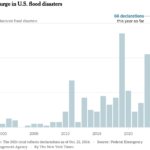As a credit analyst I was trained to describe the circumstances that caused a particular credit impact. That led to then offering opinions about the outlook of the impact of events and risks.
I learned this after the default of the Washington Public Power Supply System (WPPSS) bonds, big things can fail. Recall that the federal government then predicted demand growth to require significant new generation to supply the needs of the expanding economy in the Pacific Northwest. Demand was increasing at more than a 7% pace and nuclear generation was going to be an answer to balance the grid that was dominated by hydro-resources. As the story goes, demand fell with the introduction of significant federal energy efficiency standards and conservation programs and a downward turn in the economy. Rather than 5 new nuclear units, demand required only one unit to be built which resulted in the largest municipal bond default in US history. Years alter I recall riding by the half-constructed concrete shells of the WPPSS Units One and Two not constructed and wondered how such a thing could have happened.
While the parallel is not perfect, the word caution comes to mind as the US is in a frenzy of AI and data server development. I reviewed the rating agency power sector outlook reports from 2022 and found almost no reference to data centers and AI. Suddenly, utility management is faced with electric capacity shortages and spiraling prices. The PJM market is a case in point.
The question that needs to be addressed is how many data centers can be developed without affecting other electricity customers and is there a cliff that exists should such demand all of a sudden shifts like what happened with WPPSS?
Will the data center energy demand compromise the transition of the sector to less carbon emissions? For example, Omaha Public Power District is being criticized for slowing the closure of its coal-fired unit given the demand growth they have had to manage. Storied Three Mile Island is being considered now for restart to ensure load growth can be managed. Forecasted capital plans are increasing with new debt leverage. What would happen should demand slow and the data centers lights dim.
You can’t ask AI these questions because I suspect the AI response will be a lie. But I did ask Goggle AI, and the response was honest but self-serving:
“AI is a very energy-intensive technology that requires a lot of electricity to process and analyze data. And efforts should be made to optimize AI systems to minimize energy consumption while maintaining functionality; this can be achieved through advancements in hardware design, model optimization techniques, and responsible deployment strategies that prioritize energy efficiency.”
My opinion is that there indeed needs to be new strategies to ensure that affordability and reliability of electricity for customers along with building more resiliency in the infrastructure should be at the forefront of policies and risk management as AI becomes more dominant.
Dan Aschenbach
AGVP Advisory
danaschenbach@agvpadvisory.net




